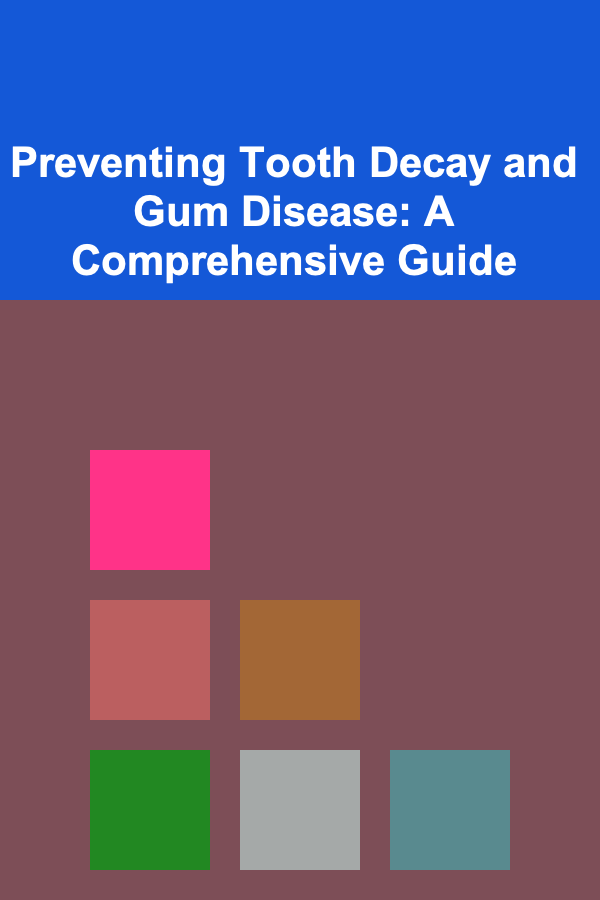
Preventing Tooth Decay and Gum Disease: A Comprehensive Guide
ebook include PDF & Audio bundle (Micro Guide)
$12.99$7.99
Limited Time Offer! Order within the next:

Maintaining good oral health is crucial for overall well-being. Tooth decay (dental caries) and gum disease (periodontal disease) are two of the most common oral health problems affecting people of all ages. While they are prevalent, they are also largely preventable. This comprehensive guide will delve into the causes, prevention, and management of tooth decay and gum disease, providing you with the knowledge and tools to protect your smile for life.
Understanding Tooth Decay
Tooth decay is the destruction of tooth enamel, the hard, outer layer of your teeth. It's caused by bacteria in your mouth that produce acids from sugars and carbohydrates you eat and drink. Over time, these acids erode the enamel, leading to cavities (holes) in the teeth.
The Process of Tooth Decay
- Plaque Formation: Plaque is a sticky film of bacteria that constantly forms on your teeth. It's colorless and often difficult to see, especially at first.
- Acid Production: When you eat or drink sugary or starchy foods, the bacteria in plaque metabolize these carbohydrates, producing acids as a byproduct.
- Enamel Erosion: These acids attack the tooth enamel, weakening and dissolving it. This process, known as demineralization, initially creates microscopic pores in the enamel.
- Cavity Formation: If demineralization continues without intervention, the enamel breaks down further, forming a visible cavity.
- Progression of Decay: Once a cavity forms, the decay can spread to the deeper layers of the tooth, including the dentin (the layer beneath the enamel) and the pulp (the innermost layer containing nerves and blood vessels). This can lead to pain, infection, and ultimately tooth loss.
Factors Contributing to Tooth Decay
- Diet: Frequent consumption of sugary and starchy foods significantly increases the risk of tooth decay. Sugary drinks, candy, pastries, and even seemingly healthy foods like fruit juices can contribute to acid production.
- Oral Hygiene: Poor oral hygiene allows plaque to accumulate and acids to attack the teeth for extended periods. Infrequent or ineffective brushing and flossing are major contributing factors.
- Saliva Flow: Saliva helps neutralize acids in the mouth, remineralize enamel, and wash away food particles and bacteria. Reduced saliva flow, often due to medications, certain medical conditions, or dehydration, increases the risk of decay.
- Fluoride Exposure: Fluoride strengthens tooth enamel and makes it more resistant to acid attacks. Insufficient fluoride exposure, whether from water, toothpaste, or professional treatments, can increase susceptibility to decay.
- Genetics: Some individuals may be genetically predisposed to tooth decay due to factors such as enamel structure or saliva composition.
- Age: Children and older adults are often more susceptible to tooth decay. Children may not have fully developed enamel and may struggle with proper oral hygiene. Older adults may experience decreased saliva flow and gum recession, making their teeth more vulnerable.
Understanding Gum Disease
Gum disease, also known as periodontal disease, is an infection of the gums and bone that support your teeth. It's primarily caused by plaque and tartar (hardened plaque) buildup along the gum line. In its early stages, gum disease is called gingivitis. If left untreated, it can progress to periodontitis, a more severe form of gum disease that can lead to tooth loss.
The Progression of Gum Disease
- Gingivitis: This is the earliest stage of gum disease, characterized by inflammation of the gums. The gums may appear red, swollen, and bleed easily when brushing or flossing. Gingivitis is often painless and can be reversed with proper oral hygiene.
- Periodontitis: If gingivitis is not treated, it can progress to periodontitis. In this stage, the inflammation extends beyond the gums and affects the bone and tissues that support the teeth. The gums may start to recede, forming pockets between the teeth and gums. These pockets become infected, leading to further bone and tissue destruction.
- Advanced Periodontitis: In the most advanced stage, the bone and tissues supporting the teeth are severely damaged. Teeth may become loose and eventually fall out or require extraction.
Factors Contributing to Gum Disease
- Plaque and Tartar Buildup: The primary cause of gum disease is the accumulation of plaque and tartar along the gum line. Bacteria in plaque release toxins that irritate and inflame the gums.
- Poor Oral Hygiene: Inadequate brushing and flossing allow plaque and tartar to build up, increasing the risk of gum disease.
- Smoking and Tobacco Use: Smoking is a major risk factor for gum disease. It weakens the immune system, making it harder for the body to fight off infection. Smoking also reduces blood flow to the gums, impairing healing.
- Genetics: Some individuals may be genetically predisposed to gum disease.
- Systemic Diseases: Certain systemic diseases, such as diabetes, can increase the risk of gum disease. Diabetes can impair the body's ability to fight infection and slow down healing.
- Medications: Some medications, such as those that cause dry mouth, can increase the risk of gum disease.
- Hormonal Changes: Hormonal changes, such as those that occur during pregnancy or menopause, can make the gums more susceptible to inflammation.
- Poor Nutrition: A diet lacking in essential nutrients can weaken the immune system and increase the risk of gum disease.
- Stress: Chronic stress can weaken the immune system and make it harder for the body to fight off infection.
Strategies for Preventing Tooth Decay and Gum Disease
Preventing tooth decay and gum disease requires a multi-faceted approach that includes proper oral hygiene, a healthy diet, regular dental checkups, and other preventive measures.
1. Mastering Oral Hygiene
Effective oral hygiene is the cornerstone of preventing both tooth decay and gum disease. Here's a detailed breakdown of essential practices:
- Brushing Techniques:
- Frequency: Brush your teeth at least twice a day, ideally after meals and before bedtime.
- Duration: Brush for at least two minutes each time. Use a timer or a song to ensure you're brushing for the recommended duration.
- Toothbrush Selection: Use a soft-bristled toothbrush. Hard bristles can damage your gums and enamel. Consider using an electric toothbrush, which can be more effective at removing plaque.
- Technique:
- Angle: Hold the toothbrush at a 45-degree angle to your gums.
- Movement: Use gentle, short, back-and-forth strokes.
- Coverage: Brush all surfaces of each tooth -- the outer surface, the inner surface, and the chewing surface. Don't forget to brush your tongue to remove bacteria and freshen your breath.
- Toothpaste: Use fluoride toothpaste. Fluoride strengthens enamel and helps prevent decay.
- Replacement: Replace your toothbrush every three to four months, or sooner if the bristles are frayed.
- Flossing:
- Frequency: Floss at least once a day, preferably before bedtime.
- Technique:
- Length of Floss: Use about 18 inches of floss.
- Grip: Wrap the floss around your middle fingers, leaving a few inches to work with.
- Guide: Gently guide the floss between your teeth using a sawing motion.
- Curve: Curve the floss around each tooth in a "C" shape.
- Movement: Slide the floss up and down against the tooth surface, getting below the gum line.
- Clean Floss: Use a clean section of floss for each tooth.
- Alternatives: If you have difficulty using traditional floss, consider using floss picks or interdental brushes.
- Mouthwash:
- Purpose: Use an antiseptic mouthwash to help kill bacteria and freshen your breath.
- Timing: Rinse with mouthwash after brushing and flossing.
- Selection: Choose a mouthwash that contains fluoride and is alcohol-free (to avoid drying out your mouth).
2. Adopting a Healthy Diet
Your diet plays a significant role in your oral health. Making informed food choices can significantly reduce your risk of tooth decay and gum disease.
- Limit Sugary and Starchy Foods:
- Frequency: Reduce the frequency of consuming sugary and starchy foods and drinks. Avoid snacking on these items throughout the day.
- Timing: If you do consume sugary or starchy foods, do so during meals rather than between meals. Saliva production increases during meals, helping to neutralize acids.
- Hidden Sugars: Be aware of hidden sugars in processed foods, sauces, and condiments. Read food labels carefully.
- Choose Nutritious Foods:
- Fruits and Vegetables: Eat plenty of fruits and vegetables, which are rich in vitamins, minerals, and fiber. Crunchy fruits and vegetables, such as apples and carrots, can help clean your teeth.
- Dairy Products: Consume dairy products, such as milk and cheese, which are rich in calcium and phosphorus, essential for strong teeth.
- Lean Protein: Include lean protein sources, such as fish, poultry, and beans, in your diet.
- Water: Drink plenty of water throughout the day, especially after meals. Water helps rinse away food particles and bacteria.
- Avoid Sugary Drinks:
- Soda: Avoid soda and other sugary drinks. These drinks are highly acidic and can erode enamel.
- Juice: Limit your consumption of fruit juice, even 100% juice, as it is high in sugar.
- Sports Drinks: Be cautious of sports drinks, which can also be high in sugar.
- Consider Sugar-Free Alternatives:
- Sugar-Free Gum: Chewing sugar-free gum after meals can help stimulate saliva flow, which can neutralize acids and remineralize enamel. Look for gum containing xylitol, which has been shown to inhibit the growth of bacteria that cause tooth decay.
- Sugar-Free Candies: Opt for sugar-free candies or mints.
3. Scheduling Regular Dental Checkups
Regular dental checkups are essential for early detection and prevention of oral health problems. Your dentist can identify signs of tooth decay and gum disease in their early stages, when they are easier to treat.
- Frequency: Schedule dental checkups at least twice a year, or more frequently if recommended by your dentist.
- Professional Cleanings: During your checkup, your dentist will perform a professional cleaning to remove plaque and tartar buildup.
- Examinations: Your dentist will examine your teeth and gums for signs of tooth decay, gum disease, and other oral health problems.
- X-rays: X-rays may be taken to detect decay between teeth and other problems that are not visible during a visual examination.
- Personalized Recommendations: Your dentist can provide you with personalized recommendations for improving your oral hygiene and preventing tooth decay and gum disease.
4. Utilizing Fluoride
Fluoride is a naturally occurring mineral that strengthens tooth enamel and makes it more resistant to acid attacks. It's a key component in preventing tooth decay.
- Fluoridated Water: Drink fluoridated water. Many communities add fluoride to their water supply to promote dental health.
- Fluoride Toothpaste: Use fluoride toothpaste when brushing your teeth.
- Fluoride Mouthwash: Use a fluoride mouthwash to rinse your mouth after brushing.
- Professional Fluoride Treatments: Ask your dentist about professional fluoride treatments, such as fluoride varnish or gel. These treatments provide a higher concentration of fluoride than over-the-counter products.
5. Managing Dry Mouth
Saliva plays a vital role in protecting your teeth. Dry mouth (xerostomia) increases your risk of tooth decay and gum disease.
- Identify the Cause: Determine the cause of your dry mouth. It may be due to medications, medical conditions, or dehydration.
- Stay Hydrated: Drink plenty of water throughout the day.
- Saliva Stimulants: Chew sugar-free gum or suck on sugar-free candies to stimulate saliva flow.
- Artificial Saliva: Use artificial saliva products, such as sprays or lozenges, to keep your mouth moist.
- Humidifier: Use a humidifier, especially at night, to add moisture to the air.
- Consult Your Doctor: If your dry mouth is caused by medications, talk to your doctor about possible alternatives.
6. Quitting Smoking and Tobacco Use
Smoking and tobacco use are major risk factors for gum disease and other oral health problems. Quitting is one of the best things you can do for your oral health and overall health.
- Seek Help: Talk to your doctor or dentist about resources available to help you quit smoking.
- Nicotine Replacement Therapy: Consider using nicotine replacement therapy, such as patches, gum, or lozenges.
- Support Groups: Join a support group for smokers who are trying to quit.
- Avoid Triggers: Identify and avoid triggers that make you want to smoke.
7. Managing Systemic Diseases
Certain systemic diseases, such as diabetes, can increase your risk of gum disease. Properly managing these conditions is essential for maintaining good oral health.
- Diabetes Control: If you have diabetes, work with your doctor to keep your blood sugar levels under control.
- Regular Monitoring: Monitor your blood sugar levels regularly.
- Healthy Lifestyle: Adopt a healthy lifestyle that includes a balanced diet, regular exercise, and stress management.
- Inform Your Dentist: Inform your dentist about any systemic diseases you have.
8. Early Detection and Treatment
Early detection and treatment of tooth decay and gum disease are crucial for preventing further damage and complications.
- Be Aware of Symptoms: Be aware of the symptoms of tooth decay and gum disease, such as toothache, sensitivity to hot or cold, bleeding gums, and bad breath.
- See Your Dentist Promptly: If you experience any of these symptoms, see your dentist promptly.
- Follow Treatment Recommendations: Follow your dentist's treatment recommendations carefully.
Special Considerations
Certain groups may require special considerations when it comes to preventing tooth decay and gum disease.
Children
- Infant Oral Hygiene: Start cleaning your baby's gums with a soft cloth even before their teeth erupt.
- Brushing Assistance: Help young children brush their teeth until they are able to do so effectively on their own (usually around age 7 or 8).
- Fluoride Supplementation: Ask your dentist or pediatrician about fluoride supplementation for children who are not getting enough fluoride from their water supply.
- Sealants: Consider dental sealants for children. Sealants are thin, plastic coatings applied to the chewing surfaces of molars to protect them from decay.
Pregnant Women
- Increased Risk: Pregnant women are at increased risk of gum disease due to hormonal changes.
- Good Oral Hygiene: Maintain excellent oral hygiene during pregnancy.
- Dental Checkups: Schedule regular dental checkups during pregnancy.
- Avoid X-rays: Avoid dental x-rays during pregnancy, unless absolutely necessary.
Older Adults
- Dry Mouth: Older adults are more likely to experience dry mouth due to medications and other factors.
- Gum Recession: Gum recession is common in older adults, making their teeth more vulnerable to decay.
- Denture Care: If you wear dentures, clean them regularly and see your dentist for adjustments as needed.
Conclusion
Preventing tooth decay and gum disease is a lifelong commitment to good oral hygiene, a healthy diet, and regular dental care. By understanding the causes and risk factors of these conditions and implementing the strategies outlined in this guide, you can protect your smile and enjoy a lifetime of good oral health. Remember to consult with your dentist for personalized advice and treatment recommendations.

How to Handle Pet Emergencies: First Aid Basics
Read More
How to Maintain Your Home's HVAC System for Optimal Efficiency
Read More
How to Use Social Media to Promote Your Rental Property
Read More
Navigating Regulatory Challenges: Essential Knowledge for Healthcare Consultants
Read More
How to Rebrand Your Business Effectively
Read More
How to Explore the Benefits of Cryotherapy
Read MoreOther Products

How to Handle Pet Emergencies: First Aid Basics
Read More
How to Maintain Your Home's HVAC System for Optimal Efficiency
Read More
How to Use Social Media to Promote Your Rental Property
Read More
Navigating Regulatory Challenges: Essential Knowledge for Healthcare Consultants
Read More
How to Rebrand Your Business Effectively
Read More